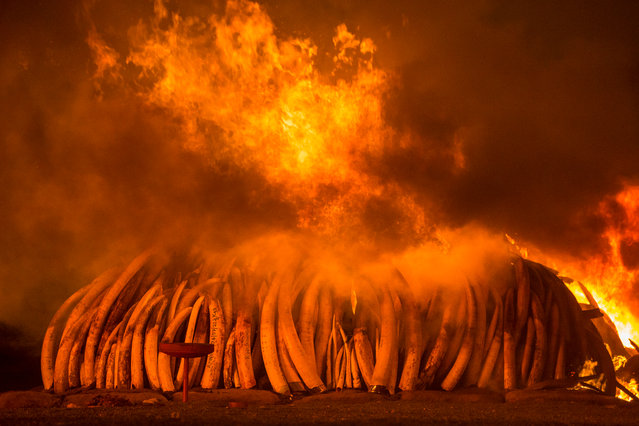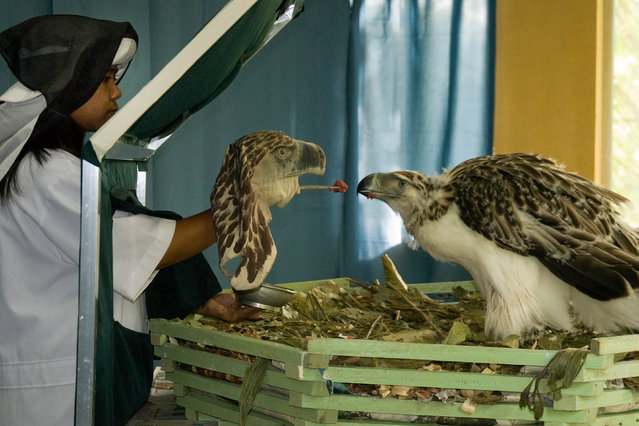
In a new project, an international group of photographers have joined forces to use their powerful images to raise awareness and funds to help stop the illegal wildlife trade. Here: A thresher shark caught in a gillnet in Mexico’s Sea of Cortez. Tens of millions of sharks die each year as victims of fishing by-catch or to satisfy the demand for shark fin soup. (Photo by Brian Skerry/Photographers Against Wildlife Crime/Wildscreen/The Guardian)

Approximately 4,000 pangolins defrosting after their seizure, hidden inside a shipping container at a port in Sumatra, Indonesia. This was one of the largest seizures of the animals on record. Pangolin scales are used in traditional Chinese medicine and their flesh is regarded as a delicacy. (Photo by Paul Hilton/Photographers Against Wildlife Crime/Wildscreen/The Guardian)

An aerial view of indigenous land in the region of Altamira in the Brazilian Amazon, cleared for illegal logging. (Photo by Daniel Beltra/Photographers Against Wildlife Crime/Wildscreen/The Guardian)

Three times a day, this orangutan steps from its cage into the limelight, dressed in a costume to accompany a clown at Chimelong International Circus in China. Bornean orangutans are endangered. Many are captured from the wild for the illegal pet trade and sadly some end up on stage performing. Audiences are often unaware of the level of cruelty these animals face – enduring brutal training, neglect and abuse. (Photo by Britta Jaschinski/Photographers Against Wildlife Crime/Wildscreen/The Guardian)

Fennec foxes are captured for the illegal pet trade. This three-month-old pup was for sale in a market in southern Tunisia. (Photo by Bruno D'Amicis/Photographers Against Wildlife Crime/Wildscreen/The Guardian)

This bull elephant will end his life in chains in Nepal’s Chitwan national park, a consequence of having killed five mahouts during his lifetime. (Photo by Patrick Brown/Photographers Against Wildlife Crime/Wildscreen/The Guardian)

On 30 April 2016, Kenya staged its biggest ever ivory burn – 105 tonnes at Nairobi national park. (Photo by Charlie Hamilton James/National Geographic/Photographers Against Wildlife Crime/Wildscreen/The Guardian)

This orphaned baby gorilla for sale in a Cameroon bush meat market was traded by the photographer for a worthless ring and taken to a sanctuary at the other end of the country. It died a few months later. (Photo by Karl Ammann/Photographers Against Wildlife Crime/Wildscreen/The Guardian)

The smouldering remains of an area of Amazon rainforest cleared using slash and burn for cattle ranching, Acre, Brazil. (Photo by Charlie Hamilton James/Photographers Against Wildlife Crime/Wildscreen/The Guardian)

Endangered ring-tailed lemurs at Whenzou Zoo, in Zhejiang, China. Conservationists place this species numbers at as few as 2,000 individuals in the wild due to habitat loss, poaching and hunting. (Photo by Zheng Xiaoqun/Photographers Against Wildlife Crime/Wildscreen/The Guardian)

Confiscated rhino hooves of two adults (male and female) and one calf. The US Fish and Wildlife Service stores 1.3 million seized items at a warehouse in Colorado. (Photo by Britta Jaschinski/Photographers Against Wildlife Crime/Wildscreen/The Guardian)

A volunteer with the NGO, Care for Wild Africa, comforts a baby rhino after undergoing treatment for injuries caused by hyenas. The rhino was orphaned after its mother was killed by poachers in Kruger national park. She was luckier than most as many calves who see their mothers killed are also attacked by the poachers, using machetes to break their spines so they cannot run away. (Photo by Brent Stirton/Getty Images Reportage/Photographers Against Wildlife Crime/Wildscreen/The Guardian)

Thandi, the female white rhino who lost her horn to poachers, has become a symbol of survival in the fight against rhino poaching. (Photo by Neil Aldridge/Photographers Against Wildlife Crime/Wildscreen/The Guardian)

A captive-bred Philippine eagle is hand fed at the Philippine Eagle Center. Loss of habitat due to deforestation means these eagles are critically endangered. Some captive-bred birds have been released back into the wild. (Photo by Klaus Nigge/Photographers Against Wildlife Crime/Wildscreen/The Guardian)

Tony Fitzjohn, conservationist and protégé of George Adamson, with Jipe, a lion he raised from orphaned cub to full adult in three years and then released back into the wild. Jipe successfully bred and raised cubs in Tsavo, Kenya, but was killed by poachers soon after this photo was taken. (Photo by Olly & Suzi/Photographers Against Wildlife Crime/Wildscreen/The Guardian)

A gorilla in the hands of her carer as they drive to a new and larger sanctuary run for the care of orphaned or captive apes rescued by Ape Action Africa in Cameroon. (Photo by Jo-Anne McArthur/Photographers Against Wildlife Crime/Wildscreen/The Guardian)

A pair of young Bengal tigers in India’s Ranthambore national park. Less than 4,000 tigers are left in the wild, a consequence in part due to poaching to supply consumer demand for their body parts, mostly in China and southeast Asia. (Photo by Sudhir Shivaram/Photographers Against Wildlife Crime/Wildscreen/The Guardian)

The mahout who has raised this elephant orphan from SA has formed a trusted bond. The elephants are raised to maturity and released as part of a long term study of rehabilitated animals in Abu Camp, Okavango, Botswana. (Photo by Chris Packham/Photographers Against Wildlife Crime/Wildscreen/The Guardian)
17 Oct 2017 06:05:00,
post received
0 comments
